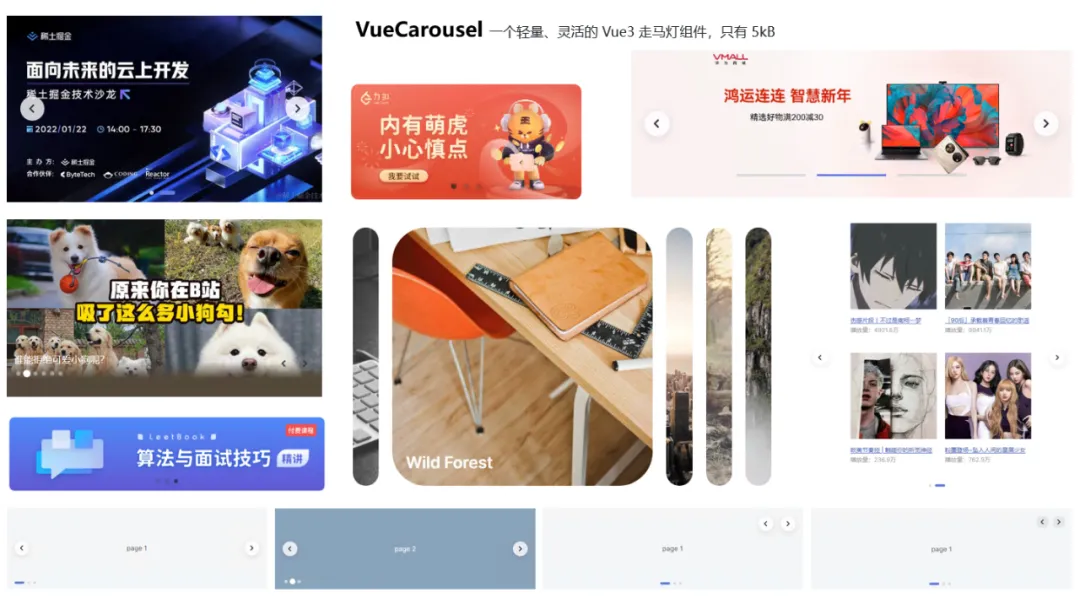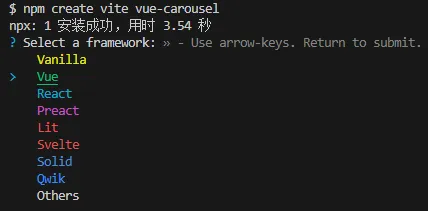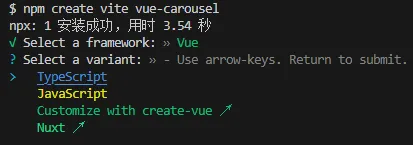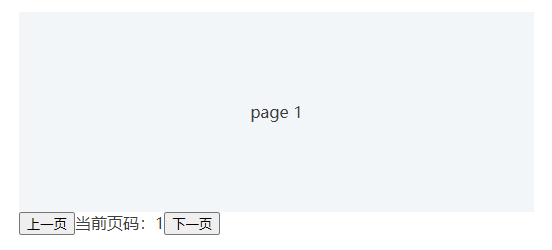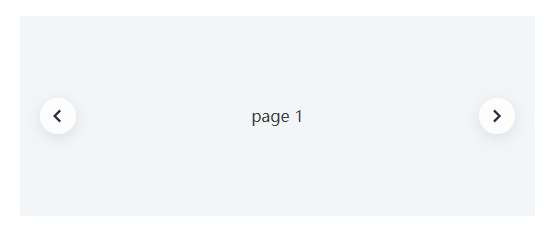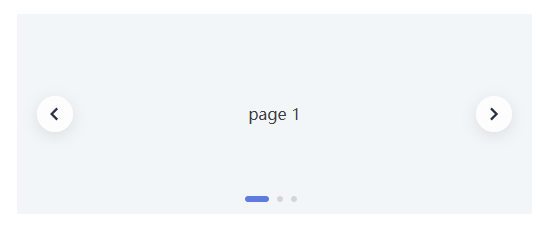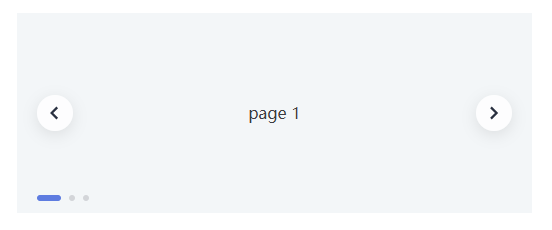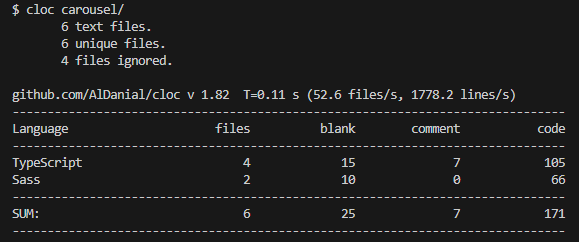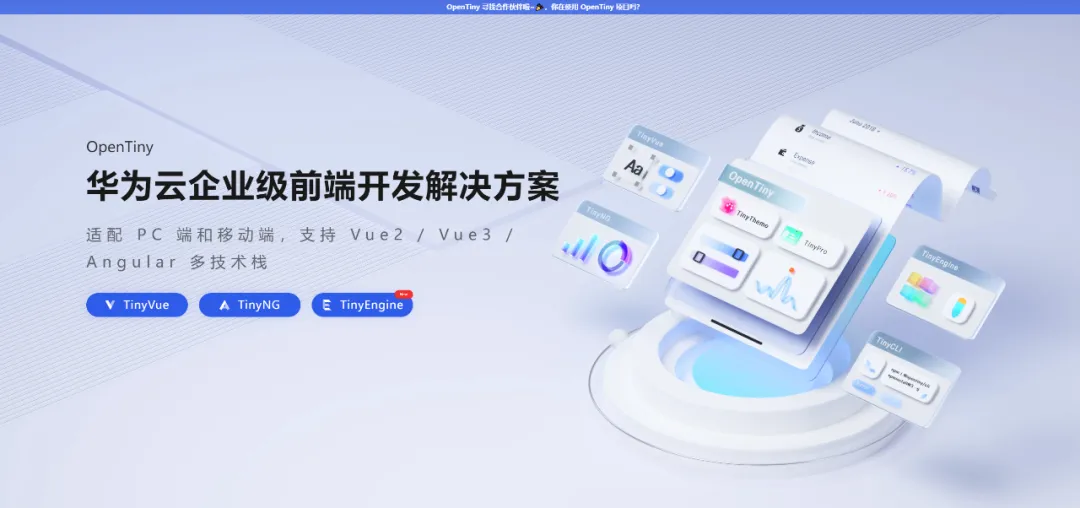手把手带你开发一个易用又灵活的 Carousel 组件
本文由体验技术团队Kagol同学创作~
前端组件库作为 Web 应用开发重要的基石,发挥了用户体验统一和开发效率提升的双层价值,但业务场景变化和需求变化万千,没有任何组件库可以满足所有业务场景,但我们依然可以通过精心的 API 设计,让组件在易用性和灵活性这两个看似矛盾的能力中取得平衡,覆盖尽可能丰富的业务场景,在业务开发中发挥更大的价值。
本文主要以 Carousel 走马灯组件为例,给大家分享我的组件设计经验,如何通过子组件+插槽的设计思想,让组件在易用性和灵活性之间取得平衡。
先来看下我们要实现的 VueCarousel 组件的效果图:
可以看到它的功能是很强大的,可以应用于丰富的业务场景,接下来就带大家一起来设计和实现 VueCarousel。
实现步骤
1、创建初始项目工程
先使用 vite 命令行工具创建一个初始项目工程。
npm create vite vue-carousel
cd vue-carousel
npm i
npm run dev
然后安装必要的依赖。
npm i -D @vitejs/plugin-vue-jsx sass
配置下 vite.config.ts
import { defineConfig } from 'vite'
import vue from '@vitejs/plugin-vue'
++ import vueJsx from '@vitejs/plugin-vue-jsx'
++ import path from 'path'
// https://vitejs.dev/config/
export default defineConfig({
-- plugins: [vue()],
++ plugins: [vue(), vueJsx()],
++ resolve: {
++ alias: [
++ { find: '@kagol/vue-carousel', replacement: path.resolve(__dirname, 'carousel') }
++ ]
}
})
2、创建空的 Carousel 组件
在实现具体的组件功能之前,我们先创建一个空的组件结构,走通组件本地效果预览的流程。
先看下这个组件怎么使用。
在 src/main.ts 中导入和注册组件插件:
import { createApp } from 'vue'
++ import Carousel from '@kagol/vue-carousel'
import './style.css'
import App from './App.vue'
-- createApp(App).mount('#app')
++ createApp(App).use(Carousel).mount('#app')
然后在 src/App.vue 中使用:
<template>
<HelloWorld msg="Vite + Vue" />
++ <XCarousel />
</template>
接下来设计这个组件的目录结构:
vue-carousel
├── carousel
| ├── index.ts
| └── src
| ├── carousel.scss
| └── carousel.tsx
先编写入口文件 carousel/index.ts
import type { App } from 'vue'
import XCarousel from './src/carousel'
export { XCarousel }
export default {
install(app: App) {
app.component(XCarousel.name, XCarousel)
}
}
然后是定义组件 carousel/src/carousel.tsx
import { defineComponent } from 'vue'
import './carousel.scss'
export default defineComponent({
name: 'XCarousel',
setup(props, context) {
return () => {
return <div class="x-carousel">XCarousel</div>
}
}
})
编写样式 carousel/src/carousel.scss
.x-carousel {
color: red;
}
效果如下:
3、增加 usePage 实现基础分页能力
接下来实现组件逻辑,Carousel 组件本质上是一个简化的分页组件。
先实现分页逻辑 composables/use-page.ts
import { ref } from 'vue'
export default function usePage(defaultPageIndex = 1) {
// 当前页码
const pageIndex = ref(defaultPageIndex)
// 跳到第几页
const setPageIndex = (current: number) => {
pageIndex.value = current
}
// 一次性往前(或往后)跳几页
const jumpPage = (page: number) => {
pageIndex.value += page
}
// 上一页
const prevPage = () => jumpPage(-1)
// 下一页
const nextPage = () => jumpPage(1)
return { pageIndex, setPageIndex, jumpPage, prevPage, nextPage }
}
然后配合 UI 展示 carousel.tsx
import { defineComponent } from 'vue'
++ import usePage from './composables/use-page'
import './carousel.scss'
export default defineComponent({
name: 'XCarousel',
setup(props, context) {
++ const { pageIndex, prevPage, nextPage } = usePage(1)
return () => {
-- return <div class="x-carousel">XCarousel</div>
++ return <div class="x-carousel">
++ <button onClick={ prevPage }>上一页</button>
++ <span>当前页码:{ pageIndex.value }</span>
++ <button onClick={ nextPage }>下一页</button>
++ </div>
}
}
})
carousel/src/carousel.scss
.x-carousel {
-- color: red;
++ color: #3c3c43;
}
效果如下:
点击上一个、下一页按钮可以切换页码。
4、实现 Carousel 基础功能
我们再配合轮播内容,实现 Carousel 基础功能。
carousel.tsx
import { defineComponent, renderSlot, useSlots } from 'vue'
import usePage from './composables/use-page'
import './carousel.scss'
export default defineComponent({
name: 'XCarousel',
setup(props, context) {
const { pageIndex, prevPage, nextPage } = usePage(1)
++ // 获取插槽内容中的元素数量
++ const count = useSlots().default().length
return () => {
return <div class="x-carousel">
++ <div class="x-carousel-item-container" style={{
++ width: count * 100 + '%', // 根据内容元素的数量计算容器宽度
++ left: - (pageIndex.value - 1) * 100 + '%', // 根据当前页码计算容器偏移的位置,从而显示特定的元素内容
++ }}>{renderSlot(useSlots(), 'default')}</div>
<button onClick={ prevPage }>上一页</button>
<span>当前页码:{ pageIndex.value }</span>
<button onClick={ nextPage }>下一页</button>
</div>
}
}
})
carousel/src/carousel.scss
.x-carousel {
++ overflow: hidden;
color: #3c3c43;
}
++ .x-carousel-item-container {
++ display: flex;
++ position: relative;
++
++ & > * {
++ flex: 1;
++ }
++}
在 App.vue 中使用:
<template>
-- <XCarousel />
++ <XCarousel>
++ <div class="carousel-item">page 1</div>
++ <div class="carousel-item">page 2</div>
++ <div class="carousel-item">page 3</div>
++ </XCarousel>
</template>
<style scoped>
++.carousel-item {
++ text-align: center;
++ line-height: 200px;
++ background: #f3f6f8;
++}
</style>
效果如下:
点击上一页、下一页,不仅页码会变化,上面的轮播内容也会跟随变化,基础功能已实现,接下来就是完善分页器样式,并增加页码指示器,让 Carousel 组件的功能更加完整。
5、增加分页器
用一个向左和向右的箭头图标代替之前的上一页、下一页按钮。
carousel.tsx
import { defineComponent, renderSlot, useSlots } from 'vue'
import usePage from './composables/use-page'
import './carousel.scss'
export default defineComponent({
name: 'XCarousel',
setup(props, context) {
const { pageIndex, prevPage, nextPage } = usePage(1)
// 获取插槽内容中的元素数量
const count = useSlots().default().length
return () => {
return <div class="x-carousel">
<div class="x-carousel-item-container" style={{
width: count * 100 + '%', // 根据内容元素的数量计算容器宽度
left: - (pageIndex.value - 1) * 100 + '%', // 根据当前页码计算容器偏移的位置,从而显示特定的元素内容
}}>{renderSlot(useSlots(), 'default')}</div>
-- <button onClick={ prevPage }>上一页</button>
-- <span>当前页码:{ pageIndex.value }</span>
-- <button onClick={ nextPage }>下一页</button>
++ <div class="x-carousel-pagination">
++ <button class="arrow arrow-left" onClick={ prevPage }>
++ <svg width="18px" height="18px" viewBox="0 0 16 16">XXX</svg>
++ </button>
++ <button class="arrow arrow-right" onClick={ nextPage }>
++ <svg width="18px" height="18px" viewBox="0 0 16 16" version="1.1">XXX</svg>
++ </button>
++ </div>
</div>
}
}
})
并调整对应的样式,增加切换时的动效。
carousel.scss
.x-carousel {
++ position: relative;
overflow: hidden;
color: #3c3c43;
}
.x-carousel-item-container {
display: flex;
position: relative;
++ transition: left 500ms ease 0s; // 内容切换时的动效
& > * {
flex: 1;
}
}
++.x-carousel-pagination {
++ position: absolute;
++ width: 100%;
++ top: 50%;
++ display: flex;
++ justify-content: space-between;
++ margin-top: -18px;
++
++ .arrow {
++ cursor: pointer;
++ width: 36px;
++ height: 36px;
++ border-radius: 18px;
++ background: rgba(255, 255, 255, .8);
++ box-shadow: 0 4px 16px 0 rgba(0, 0, 0, .1);
++ display: inline-flex;
++ align-items: center;
++ justify-content: center;
++ border: 0;
++ outline: 0;
++ transition: background-color .3s cubic-bezier(.645, .045, .355, 1); // 按钮hover时的动效
++
++ &:hover {
++ background: #f8f8f8;
++ }
++
++ &.arrow-left {
++ margin-left: 20px;
++ }
++
++ &.arrow-right {
++ margin-right: 20px;
++ }
++ }
++}
效果如下:
6、增加页码指示器
为了了解当前轮播到了哪一页,还需要增加增加页码指示器,页码指示器其实就类似分页组件里面的页码,只是一般显示成小圆点,而不是数字。
carousel.tsx
import { defineComponent, renderSlot, useSlots } from 'vue'
import usePage from './composables/use-page'
import './carousel.scss'
export default defineComponent({
name: 'XCarousel',
setup(props, context) {
// 跳转特定页码时,需要使用到 setPageIndex 方法
const { pageIndex, prevPage, nextPage, setPageIndex } = usePage(1)
// 获取插槽内容中的元素数量
const count = useSlots().default().length
++ // 生成指示器数组
++ const indicatorArr = Array.from(new Array(count).keys())
return () => {
return <div class="x-carousel">
<div class="x-carousel-item-container" style={{
width: count * 100 + '%', // 根据内容元素的数量计算容器宽度
left: - (pageIndex.value - 1) * 100 + '%', // 根据当前页码计算容器偏移的位置,从而显示特定的元素内容
}}>{renderSlot(useSlots(), 'default')}</div>
<div class="x-carousel-pagination">
<button class="arrow arrow-left" onClick={ prevPage }>
<svg width="18px" height="18px" viewBox="0 0 16 16">XXX</svg>
</button>
<button class="arrow arrow-right" onClick={ nextPage }>
<svg width="18px" height="18px" viewBox="0 0 16 16" version="1.1">XXX</svg>
</button>
</div>
++ <div class="x-carousel-indicator">
++ {
++ indicatorArr.map((item, index) => {
++ return <div class={`x-carousel-indicator-item${pageIndex.value === index+1 ? ' active' : ''}`} onClick={() => setPageIndex(index + 1)}></div>
++ })
++ }
++ </div>
</div>
}
}
})
调整下样式 carousel.scss
...
++.x-carousel-indicator {
++ display: flex;
++ position: absolute;
++ bottom: 12px;
++ justify-content: center;
++ width: 100%;
++
++ .x-carousel-indicator-item {
++ cursor: pointer;
++ width: 6px;
++ height: 6px;
++ border-radius: 3px;
++ margin-right: 8px;
++ background: #d3d5d9;
++
++ &.active {
++ width: 24px;
++ background: #5e7ce0;
++ transition: all .3s cubic-bezier(.645, .045, .355, 1); // 切换内容时指示器小圆点上的动效
++ }
++ }
++}
效果如下:
至此,一个功能完整的 Carousel 组件就完成了,但这个组件是一个封装好的组件,开发者不能灵活进行扩展和定制。
7、增加灵活性:子组件+插槽
为了增加组件的灵活性,让用户可以自定义一些内容,我们需要做两件事:
- 将子组件抽取出来,并暴露给开发者
- 设置对应的插槽,让开发者可以放置自己的内容,当然也可以放置我们暴露出去的子组件
我们以页码指示器这个子组件为例,其他子组件同理。
先定义一个 CarouselIndicator 子组件。
carousel/src/components/carousel-indicator.tsx
import { defineComponent, toRefs, watch } from 'vue'
import usePage from '../composables/use-page'
import './carousel-indicator.scss'
export default defineComponent({
name: 'XCarouselIndicator',
props: {
modelValue: {
type: Number,
},
count: {
type: Number,
}
},
emits: ['update:modelValue'],
setup(props, { emit, slots }) {
const { modelValue } = toRefs(props)
const { pageIndex, setPageIndex } = usePage(modelValue.value)
const indicatorArr = Array.from(new Array(props.count).keys())
watch(modelValue, (newVal: number) => {
pageIndex.value = newVal
})
watch(pageIndex, (newVal: number) => {
emit('update:modelValue', newVal)
})
return () => {
return <div class="x-carousel-indicator">
{
slots.default
? slots.default({
pageIndex: pageIndex.value,
setPageIndex
})
: indicatorArr.map((item, index) => {
return <div class={`x-carousel-indicator-item${pageIndex.value === index+1 ? ' active' : ''}`} onClick={() => setPageIndex(index + 1)}></div>
})
}
</div>
}
}
})
carousel-indicator.scss
.x-carousel-indicator {
display: flex;
position: absolute;
bottom: 12px;
justify-content: center;
width: 100%;
.x-carousel-indicator-item {
cursor: pointer;
width: 6px;
height: 6px;
border-radius: 3px;
margin-right: 8px;
background: #d3d5d9;
&.active {
width: 24px;
background: #5e7ce0;
transition: all .3s cubic-bezier(.645, .045, .355, 1); // 切换内容时指示器小圆点上的动效
}
}
}
然后把写死的页码指示器用 CarouselIndicator 子组件替换,并增加 indicator 插槽。
carousel.tsx
import { defineComponent, renderSlot, useSlots } from 'vue'
++import XCarouselIndicator from './components/carousel-indicator'
import usePage from './composables/use-page'
import './carousel.scss'
export default defineComponent({
name: 'XCarousel',
++ components: {
++ XCarouselIndicator,
++ },
-- setup(props, context) {
++ setup(props, { slots }) {
// 跳转特定页码时,需要使用到 setPageIndex 方法
const { pageIndex, prevPage, nextPage, setPageIndex } = usePage(1)
// 获取插槽内容中的元素数量
const count = useSlots().default().length
-- // 生成指示器数组
-- const indicatorArr = Array.from(new Array(count).keys())
return () => {
return <div class="x-carousel">
<div class="x-carousel-item-container" style={{
width: count * 100 + '%', // 根据内容元素的数量计算容器宽度
left: - (pageIndex.value - 1) * 100 + '%', // 根据当前页码计算容器偏移的位置,从而显示特定的元素内容
}}>{renderSlot(useSlots(), 'default')}</div>
...
-- <div class="x-carousel-indicator">
-- {
-- indicatorArr.map((item, index) => {
-- return <div class={`x-carousel-indicator-item${pageIndex.value === index+1 ? ' active' : ''}`} onClick={() => setPageIndex(index + 1)}></div>
-- })
-- }
-- </div>
++ {slots.indicator ? (
++ slots.indicator({
++ count,
++ pageIndex: pageIndex.value,
++ setPageIndex
++ })
++ ) : (
++ <XCarouselIndicator
++ count={count}
++ v-model={pageIndex.value}
++ ></XCarouselIndicator>
++ )}
</div>
}
}
})
移除页码指示器对应的样式代码 carousel.scss
...
--.x-carousel-indicator {
-- display: flex;
-- position: absolute;
-- bottom: 12px;
-- justify-content: center;
-- width: 100%;
--
-- .x-carousel-indicator-item {
-- cursor: pointer;
-- width: 6px;
-- height: 6px;
-- border-radius: 3px;
-- margin-right: 8px;
-- background: #d3d5d9;
--
-- &.active {
-- width: 24px;
-- background: #5e7ce0;
-- transition: all .3s cubic-bezier(.645, .045, .355, 1); // 切换内容时指示器小圆点上的动效
-- }
-- }
--}
在入口文件 index.ts 中暴露 CarouselIndicator 子组件出去。
import type { App } from 'vue'
import XCarousel from './src/carousel'
++import XCarouselIndicator from './src/components/carousel-indicator'
--export { XCarousel }
++export { XCarousel, XCarouselIndicator }
export default {
install(app: App) {
app.component(XCarousel.name, XCarousel)
++ app.component(XCarouselIndicator.name, XCarouselIndicator)
}
}
重构之后,默认使用方式依然不变,展示的效果也没有任何差别。
App.vue
<XCarousel>
<div class="carousel-item">page 1</div>
<div class="carousel-item">page 2</div>
<div class="carousel-item">page 3</div>
</XCarousel>
但这个组件灵活性却增加了,我们可以通过 indicator 插槽和 CarouselIndicator 子组件,实现更多的走马灯效果,满足更多的业务场景。
比如:我们可以调整页码指示器的位置
<XCarousel>
<div class="carousel-item">page 1</div>
<div class="carousel-item">page 2</div>
<div class="carousel-item">page 3</div>
<template #indicator="page">
<XCarouselIndicator :count="page.count" v-model="page.pageIndex" @update:modelValue="page.setPageIndex"
style="justify-content: flex-start; padding-left: 20px;">
</XCarouselIndicator>
</template>
</XCarousel>
效果如下:
比如:我们可以自定义自己的指示器
<script setup lang="ts">
const indicatorArr = Array.from(new Array(3).keys())
</script>
<template>
<XCarousel>
<div class="carousel-item-dark">page 1</div>
<div class="carousel-item-dark">page 2</div>
<div class="carousel-item-dark">page 3</div>
<template #indicator="page">
<XCarouselIndicator :count="page.count" v-model="page.pageIndex" style="justify-content: flex-start; padding-left: 20px;">
<div
:class="['carousel-indicator-item', page.pageIndex === item+1 ? 'active' : '']"
v-for="item of indicatorArr"
:key="item"
@click="page.setPageIndex(item+1)"
></div>
</XCarouselIndicator>
</template>
</XCarousel>
</template>
<style scoped>
.carousel-item-dark {
text-align: center;
line-height: 200px;
background: rgb(135, 164, 186);
color: #fff;
}
.carousel-indicator-item {
position: relative;
display: inline-block;
width: 8px;
height: 8px;
margin: 4px;
border-radius: 50%;
background-color: var(--xui-icon-fill, #d3d5d9);
overflow: hidden;
cursor: pointer;
}
.carousel-indicator-item.active {
width: 14px;
height: 14px;
margin: 1px;
border-radius: 50%;
background-color: #fff;
}
</style>
效果如下:
我们甚至可以单独使用 CarouselIndicator 组件,实现一个很漂亮的手风琴式折叠卡片效果。
<template>
<XCarouselIndicator>
<template #default="page">
<div class="box">
<div :class="['panel', page.pageIndex === 1 ? 'active' : '']" @click="page.setPageIndex(1)">
<h3>Explore The World</h3>
</div>
<div :class="['panel', page.pageIndex === 2 ? 'active' : '']" @click="page.setPageIndex(2)">
<h3>Wild Forest</h3>
</div>
<div :class="['panel', page.pageIndex === 3 ? 'active' : '']" @click="page.setPageIndex(3)">
<h3>Sunny Beach</h3>
</div>
<div :class="['panel', page.pageIndex === 4 ? 'active' : '']" @click="page.setPageIndex(4)">
<h3>City on Winter</h3>
</div>
<div :class="['panel', page.pageIndex === 5 ? 'active' : '']" @click="page.setPageIndex(5)">
<h3>Mountains - Clouds</h3>
</div>
</div>
</template>
</XCarouselIndicator>
</template>
<style scoped>
.box {
display: flex;
width: 90vw;
}
.panel {
background-size: cover;
background-position: center;
background-repeat: no-repeat;
height: 40vh;
border-radius: 50px;
color: #fff;
cursor: pointer;
flex: 0.5;
margin: 10px;
position: relative;
-webkit-transition: all 700ms ease-in;
transition: all 700ms ease-in;
}
.panel:nth-child(1){
background-image: url("https://picsum.photos/1350/900?random=1");
}
.panel:nth-child(2){
background-image: url("https://picsum.photos/1350/900?random=2");
}
.panel:nth-child(3){
background-image: url("https://picsum.photos/1350/900?random=3");
}
.panel:nth-child(4){
background-image: url("https://picsum.photos/1350/900?random=4");
}
.panel:nth-child(5){
background-image: url("https://picsum.photos/1350/900?random=5");
}
.panel h3 {
font-size: 24px;
position: absolute;
bottom: 20px;
left: 20px;
margin: 0;
opacity: 0;
}
.panel.active {
flex: 5;
}
.panel.active h3 {
opacity: 1;
transition: opacity 0.3s ease-in 0.4s;
}
</style>
效果如下:
VueCarousel 通过子组件+插槽的设计方式,仅使用 171 行代码就实现了 Carousel 基础功能、调整指示器位置、自定义指示器、手风琴式折叠卡片等效果。
其实组件的很多其他部分也可以外溢出去,包括子组件、内部方法、TypeScript类型等,将这些能力外溢,把自主权交给开发者,可以有效地增加组件的灵活性,让我们设计的组件既是“易用的”,又是“灵活的”,在易用性和灵活性之间取得一定的平衡。
- VueCarousel 组件示例:https://kagol.github.io/vue-carousel/
关于OpenTiny
OpenTiny 是一套企业级 Web 前端开发解决方案,提供跨端、跨框架、跨版本的 TinyVue 组件库,包含基于 Angular+TypeScript 的 TinyNG 组件库,拥有灵活扩展的低代码引擎 TinyEngine,具备主题配置系统TinyTheme / 中后台模板 TinyPro/ TinyCLI 命令行等丰富的效率提升工具,可帮助开发者高效开发 Web 应用。
欢迎加入 OpenTiny 开源社区。添加微信小助手:opentiny-official 一起参与交流前端技术~
OpenTiny 官网:https://opentiny.design/
OpenTiny 代码仓库:https://github.com/opentiny/
TinyVue 源码:https://github.com/opentiny/tiny-vue
TinyEngine 源码: https://github.com/opentiny/tiny-engine
欢迎进入代码仓库 Star🌟TinyEngine、TinyVue、TinyNG、TinyCLI~
如果你也想要共建,可以进入代码仓库,找到 good first issue标签,一起参与开源贡献~
